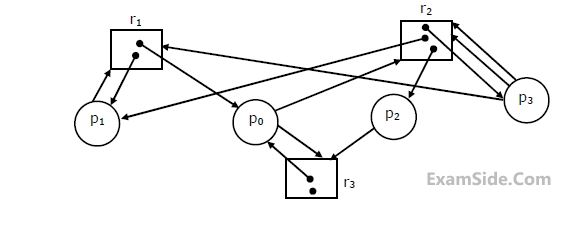Deadlocks · Operating Systems · GATE CSE
Marks 1
Consider the following threads, T1, T2 and T3 executing on a single processor, synchronized using three binary semaphore variables, S1, S2 and S3, operated upon using standard wait( ) and signal( ). The threads can be context switched in any order and at any time.
| $${T_1}$$ | $${T_2}$$ | $${T_3}$$ |
|---|---|---|
| while (true) { wait ($${S_3}$$); print ("C"); signal ($${S_2}$$); } |
while (true) { wait ($${S_1}$$); print ("B"); signal ($${S_3}$$); } |
while (true) { wait ($${S_2}$$); print ("A") signal ($${S_1}$$); } |
Which initialization of the semaphores would print the sequence BCABCABCA....... ?
Which of the following statements is/are TRUE with respect to deadlocks?
Marks 2
$P=\left\{P_1, P_2, P_3, P_4\right\}$ consists of all active processes in an operating system.
$R=\left\{R_1, R_2, R_3, R_4\right\}$ consists of single instances of distinct types of resources in the system.
The resource allocation graph has the following assignment and claim edges.
Assignment edges: $R_1 \rightarrow P_1, R_2 \rightarrow P_2, R_3 \rightarrow P_3, R_4 \rightarrow P_4$ (the assignment edge $R_1 \rightarrow P_1$ means resource $R_1$ is assigned to process $P_1$, and so on for others) Claim edges: $P_1 \rightarrow R_2, P_2 \rightarrow R_3, P_3 \rightarrow R_1, P_2 \rightarrow R_4, P_4 \rightarrow R_2$ (the claim edge $P_1 \rightarrow R_2$ means process $P_1$ is waiting for resource $R_2$, and so on for others) Which of the following statement(s) is/are CORRECT?
Consider a multi-threaded program with two threads T1 and T2. The threads share two semaphores: s1 (initialized to 1) and s2 (initialized to 0). The threads also share a global variable x (initialized to 0). The threads execute the code shown below.
// code of T1
wait(s1);
x = x + 1;
print(x);
wait(s2);
signal(s1);
// code of T2
wait(s1);
x = x + 1;
print(x);
signal(s2);
signal(s1);
Which of the following outcomes is/are possible when threads T1 and T2 execute concurrently?
Consider the following pseudocode, where S is a semaphore intialized to 5 in line#2 an counter is a shared variable intialized to 0 in line#1. Assume that the increment operation in line#7 is not atomic.
1. int counter = 0;
2. Semaphore S = init(5);
3. void parop(void)
4. {
5. wait (S);
6. wait (S);
7. counter++;
8. signal (S);
9. signal (S);
10. }
If five threads execute the function parop concurrently, which of the following program behavior (s) is/are possible?
Consider a state of the system with the Allocation matrix as shown below, and in which $$3$$ instances of $$E$$ and $$3$$ instances of $$F$$ are the only resources available.
| Allocation | |||
|---|---|---|---|
| E | F | G | |
| P0 | 1 | 0 | 1 |
| P1 | 1 | 1 | 2 |
| P2 | 1 | 0 | 3 |
| P3 | 2 | 0 | 0 |
| Max | |||
|---|---|---|---|
| E | F | G | |
| P0 | 4 | 3 | 1 |
| P1 | 2 | 1 | 4 |
| P2 | 1 | 3 | 3 |
| P3 | 5 | 4 | 1 |
From the perspective of deadlock avoidance, which one of the following is true?
$$\,\,\,\,\,\,\,{\rm I}.$$ $$\,\,\,\,\,\,$$ Processes should acquire all their resources at the beginning of execution. If
$$\,\,\,\,\,\,\,\,\,\,\,\,\,\,\,\,\,\,$$ any resource is not available, all resources acquired so far are released
$$\,\,\,\,\,{\rm II}.$$ $$\,\,\,\,\,\,$$ The resources are numbered uniquely, and processes are allowed to request
$$\,\,\,\,\,\,\,\,\,\,\,\,\,\,\,\,\,\,\,$$ for resources only in increasing resource numbers
$$\,\,\,{\rm III}.$$ $$\,\,\,\,\,\,$$ The resources are numbered uniquely, and processes are allowed to request
$$\,\,\,\,\,\,\,\,\,\,\,\,\,\,\,\,\,\,\,$$ for resources only in decreasing resource numbers
$$\,\,\,{\rm IV}.$$ $$\,\,\,\,\,\,$$ The resources are numbered uniquely. A process is allowed to request only
$$\,\,\,\,\,\,\,\,\,\,\,\,\,\,\,\,\,\,\,$$ for a resource with resource number larger than its currently held resources
Which of the above policies can be used for preventing deadlock?
 There are 3 units of type X, 2 units of type Y and 2 units of type Z still available. The system is
currently in a safe state. Consider the following independent requests for additional resources in the current state:
There are 3 units of type X, 2 units of type Y and 2 units of type Z still available. The system is
currently in a safe state. Consider the following independent requests for additional resources in the current state:
REQ1: P0 requests 0 units of X, 0 units of Y and 2 units of Z
REQ2: P1 requests 2 units of X, 0 units of Y and 0 units of Z
semaphore n = 0;
semaphore s = 1;
void producer()
{
while(true)
{
produce();
semWait(s);
addToBuffer();
semSignal(s);
semSignal(n);
}
}void consumer()
{
while(true)
{
semWait(s);
semWait(n);
removeFromBuffer();
semSignal(s);
consume();
}
}if (i%2==0) {
if (i < n) request Ri;
if (i+2 < n) request Ri+2 ;
}
else {
if (i < n) request Rn-i;
if (i+2 < n) request Rn-i-2;
} Which one of the following statements is TRUE if all three processes run concurrently starting at time t = 0?
Which one of the following statements is TRUE if all three processes run concurrently starting at time t = 0?
Marks 5

(a) Show that the system can be in this state.
(b) What will the system do on a request by process P0 for one unit of resource type R1?

(a) Find if the system is in a deadlock state.
(b) Otherwise, find a safe sequence.